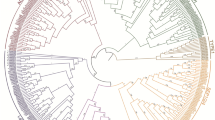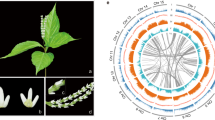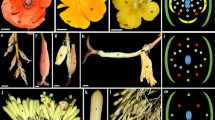Abstract
The B-class MADS-box genes composed of APETALA3 (AP3) and PISTILLATA (PI) lineages play an important role in petal and stamen identity in previously studied flowering plants. We investigated the diversification of the AP3-like and PI-like MADS-box genes of eight species in five basal angiosperm families: Amborella trichopoda (Amborellaceae); Brasenia schreberi and Cabomba caroliniana (Cabombaceae); Euryale ferox, Nuphar japonicum, and Nymphaea tetragona (Nymphaeaceae); Illicium anisatum (Illiciaceae); and Kadsura japonica (Schisandraceae). Sequence analysis showed that a four amino acid deletion in the K domain, which was found in all previously reported angiosperm PI genes, exists in a PI homologue of Schisandraceae, but not in six PI homologues of the Amborellaceae, Cabombaceae, and Nymphaeaceae, suggesting that the Amborellaceae, Cabombaceae, and Nymphaeaceae are basalmost lineages in angiosperms. The results of molecular phylogenetic analyses were not inconsistent with this hypothesis. The AP3 and PI homologues from Amborella share a sequence of five amino acids in the 5′ region of exon 7. Using the linearized tree and likelihood methods, the divergence time between the AP3 and PI lineages was estimated as somewhere between immediately after to several tens of millions of years after the split between angiosperms and extant gymnosperms. Estimates of the age of the most recent common ancestor of all extant angiosperms range from ~140–210 Ma, depending on the trees used and assumptions made.









Similar content being viewed by others
References
Adachi J, Hasegawa M (1996) MOLPHY version 2.3: programs for molecular phylogenetics based on maximum likelihood. Comput Sci Monogr 28:1–150
Alvarez-Buylla ER, Liljegren SJ, Pelaz S, Gold SE, Burgeff C, Ditta GS, Vergara-Silva F, Yanofsky MF (2000) MADS gene evolution beyond flowers, expression in pollen, endosperm, guard cells, roots, and trichomes. Plant J 24:457–466
Angiosperm Phylogeny Group (APG) II (2003) An update of angiosperm phylogeny group classification for the orders and families of flowering plants: APG II. Bot J Linn Soc 141:399–436
Barkman TJ, Chenery G, McNeal JR, Lyons-Weiler J, Ellisens W, Moore G, Wolfe AD, dePamphilis CW (2000) Independent and combined analyses of sequences from all three genomic compartments converge on the root of flowering plant phylogeny. Proc Natl Acad Sci USA 97:13166–13171
Barrier M, Robichaux RH, Purugganan MD (2001) Accelerated regulatory gene evolution in an adaptive radiation. Proc Natl Acad Sci USA 98:10208–10213
Becker A, Theissen G (2003) The major clades of MADS-box genes and their role in the development and evolution of flowering plants. Mol Phylogenet Evol 29:464–489
Becker A, Winter KU, Meyer B, Saedler H, Theissen G (2000) MADS gene diversity in seed plants 300 million years ago. Mol Biol Evol 17:1425–1434
Becker A, Kaufmann K, Freialdenhoven A, Vincent C, Li MA, Saedler H, Theissen G (2002) A novel MADS-box gene subfamily with a sister-group relationship to class B floral homeotic genes. Mol Genet Genomics 266:942–950
Borsch T, Hilu KW, Quandt D, Wilde V, Neinhuis C, Barthlott W (2003) Noncoding plastid trnT-trnF sequences reveal a well resolved phylogeny of basal angiosperms. J Evol Biol 16:558–576
Bowe LM, Coat G, dePamphilis CW (2000) Phylogeny of seed plants based on all three genomic compartments: extant gymnosperms are monophyletic and Gnetales closest relatives are conifers. Proc Natl Acad Sci USA 97:4092–4097
Bowman JL (1997) Evolutionary conservation of angiosperm flower development at the molecular and genetic levels. J Biosci 22:515–527
Bowman J, Smith DR, Meyerowitz EM (1991) Genetic interactions among floral homeotic genes of Arabidopsis. Development 112:1–20
Brandl R, Mann W, Sprinzl M (1992) Estimation of the monocot–dicot age through tRNA sequences from the chloroplast. Proc R Soc Lond Ser B 249:13–17
Brenner GJ (1996) Evidence for the earliest stage of angiosperm pollen evolution: a paleoequatorial section from Israel. In: Taylor DW, Hickey LJ (eds) Flowering plant origin, evolution and phylogeny. Chapman and Hall, New York, pp 91–115
Chase MW, Soltis DE, Olmstead RG, Morgan D, Les DH, Mishler BD, Duvall MR, Price RA, Hills HG, Qiu Y-L, Kron KA, Rettig JH, Conti E, Palmer JD, Manhart JR, Sytsma KJ, Michaels HJ, Kress WJ, Karol KG, Clark WD, Hedren M, Gaut BS, Jansen RK, Kim K-J, Wimpee CF, Smith JF, Furnier GR, Strauss SH, Xiang Q-Y, Plunkett GM, Soltis PS, Swensen SM, Williams SE, Gadek PA, Quinn CJ, Eguiarte LE, Golenberg E, Learn GH, Graham SW Jr, Barrett SCH, Dayanandan S, Albert VA (1993) Phylogenetics of seed plants: an analysis of nucleotide sequences from the plastid gene rbcL. Ann MO Bot Gard 80:528-580
Chaw SM, Parkinson CL, Cheng Y, Vincent TM, Palmer JD (2000) Seed plant phylogeny inferred from all three plant genomes: monophyly of extant gymnosperms and origin of Gnetales from conifers. Proc Natl Acad Sci USA 97:4086–4091
Crane PR, Friis EM, Pedersen KR (1995) The origin and early diversification of angiosperms. Nature 374:27–33
Coen ES, Meyerowitz EM (1991) The war of the whorls: genetic interactions controlling flower development. Nature 353:31–37
Donoghue MJ, Doyle JA (2000) Demise of the anthophyte hypothesis? Curr Biol 10:R106-R109
Eames AJ (1952) Relationships of Ephedrales. Phytomorphology 2:79–100
Endress PK (2001) The flowers in extant basal angiosperms and inferences on ancestral flowers. Int J Plant Sci 162:1111–1140
Felsenstein J (1995) PHYLIP (Phylogeny Inference Package) version 3.572c. Department of Genetics, University of Washington, Seattle
Fukui M, Futamura N, Mukai Y, Wang Y, Nagao A, Shinohara K (2001) Ancestral MADS box genes in Sugi, Cryptomeria japonica, D. Don (Taxodiaceae), homologous to the B function genes in angiosperms. Plant Cell Physiol 42:566–575
Goremykin V, Hansmann S, Martin W (1997) Evolutionary analysis of 58 proteins encoded in six completely sequenced chloroplast genomes: revised molecular estimates of two seed plant divergence times. Plant Syst Evol 206:337–351
Goremykin VV, Hirsch-Ernst KI, Wolf S, Hellwig FH (2003) Analysis of the Amborella trichopoda chloroplast genome sequence suggests that amborella is not a basal angiosperm. Mol Biol Evol 20:1499–1505
Goto K, Meyerowitz EM (1994) Function and regulation of the Arabidopsis floral homeotic gene PISTILLATA. Genes Dev 8:1548–1560
Graham SW, Olmstead RG (2000) Utility of 17 chloroplast genes for inferring the phylogeny of the basal angiosperms. Am J Bot 87:1712–1730
Hasebe M, Kofuji R, Ito M, Kato M, Iwatsuki K, Ueda K (1992) Phylogeny of gymnosperms inferred from rbcL gene sequences. Bot Mag Tokyo 105:673–679
Hasebe M, Wen CK, Kato M, Banks JA (1998) Characterization of MADS homeotic genes in the fern Ceratopteris richardii. Proc Natl Acad Sci USA 95:6222–6227
Hasegawa M, Kishino H (1994) Accuracies of the simple methods for estimating the bootstrap probability of a maximum-likelihood tree. Mol Biol Evol 11:142–145
Hughes NF (1994) The enigma of angiosperm origins. Cambridge University Press, Cambridge
Irish VF (2003) The evolution of floral homeotic gene function. BioEssays 25:637–646
Jack T, Brockman LL, Meyerowitz EM (1992) The homeotic gene APETALA3 of Arabidopsis thaliana encodes a MADS box and is expressed in petals and stamens. Cell 68:683–697
Johansen B, Pedersen LB, Skipper M, Frederiksen S (2002) MADS-box gene evolution—structure and transcription patterns. Mol Phyl Evol 23:458–480
Judd W, Campbell CS, Kellogg EA, Stevens PF, Donoghue MJ (2002) Plant systematics: a phylogenetic approach, 2nd edn. Sinauer, Sunderland, MA
Kishino H, Miyata T, Hasegawa M (1990) Maximum likelihood inference of protein phylogeny and the origin of chloroplasts. J Mol Evol 30:151–160
Kofuji R, Sumikawa N, Yamasaki M, Kondo K, Ueda K, Ito M, Hasebe M (2003) Evolution and divergence of MADS-box gene family based on genome wide expression analyses. Mol Biol Evol 20:1963–1977
Kramer EM, Irish VF (2000) Evolution of the petal and stamen development programs: evidence from comparative studies of the lower eudicots and basal angiosperms. Int J Plant Sci 161:S29-S40
Kramer EM, Dorit RL, Irish VF (1998) Molecular evolution of genes controlling petal and stamen development: duplication and divergence within the APETALA3 and PISTILLATA MADS-box gene lineages. Genetics 149:765–783
Kramer E, Stilio VSD, Schluter PM (2003) Complex patterns of gene duplication in the APETALA3 and PISTILLATA lineages of the Ranunculaceae. Int J Plant Sci 164:1–11
Lamb RS, Irish VF (2003) Functional divergence within the APETALA3/PISTILLATA floral homeotic gene lineages. Proc Natl Acad Sci USA 100:6558–6563
Larouche J, Li P, Bousquet J (1995) Mitochondrial DNA and monocot-dicot divergence time. Mol Biol Evol 12:1151–1156
Ma H, Yanofsky MF, Meyerowitz EM (1990) AGL1-AGL6, an Arabidopsis gene family with similarity to flora homeotic and transcription factor genes. Genes Dev 5:484–495
Martin W, Gierl A, Saedler H (1989) Molecular evidence for pre-Cretaceous angiosperm origins. Nature 339:46–48
Martin W, Lydiate D, Brinkmann H, Forkmann G, Saedler H, Cerff R (1993) Molecular phylogenetics in angiosperm evolution. Mol Biol Evol 10:140–162
Martinez-Castilla LP, Alvarez-Buylla ER (2003) Adaptive evolution in the Arabidopsis MADS-box gene family inferred from its complete resolved phylogeny. Proc Natl Acad Sci USA 100:13407–13412
Mathews S, Donoghue MJ (1999) The root of angiosperm phylogeny inferred from duplicate phytochrome genes. Science 286:947–950
Mathews S, Donoghue MJ (2000) Basal angiosperm phylogeny inferred from duplicated phytochromes A and C. Int J Plant Sci 161:S41-S55
Meyerowitz EM, Bowman J, Brockma, LL, Drews GN, Jack T, Sieburth LE, Weigel D (1991) A genetic and molecular model for flower development in Arabidopsis thaliana. Dev Suppl 1:157–167
Mouradov A, Hamdorf B, Teasdale RD, Kim J, Winter K-U, Theissen G (1999) A DEF/GLO-like MADSbox gene from a gymnosperm: Pinus radiata contains an ortholog of angiosperm B class floral homeotic genes. Dev Genet 25:245–252
Munster T, Pahnke J, Di Rosa A, Kim JT, Martin W, Saedler H, Theissen G (1997) Floral homeotic genes were recruited from homologous MADS genes preexisting in the common ancestor of ferns and seed plants. Proc Natl Acad Sci USA 94:2415–2420
Nam J, dePamphilis CW, Ma H, Nei M (2003) Antiquity and evolution of the MADS-box gene family controlling flower development in plants. Mol Biol Evol 20:1435–1447
Nei M, Kumar S (2000) Molecular evolution and phylogenetics. Oxford University Press, New York
Parenicova L, Folter S, Kieffer M, Hrner D, Favalli C, Busscher J, Cook HE, Ingram RM, Kater MM, Davies B, Angenent GC, Colombo L (2003) Molecular and phylogenetic analyses of the complete MADS-box transcription factor family in Arabidopsis: new openings to the MADS world. Plant Cell 15:1538–1551
Parkinson CL, Adams KL, Palmer JD (1999) Multigene analyses identify the three earliest lineages of extant flowering plants. Curr Biol 9:1485–1488
Purugganan MD (1997) The MADS-box floral homeotic gene lineages predate the origin of seed plants: phylogenetic and molecular clock estimates. J Mol Evol 45:392–396
Qiu YL, Lee J, Bernasconi-Quadroni F, Soltis DE, Soltis PS, Zanis M, Zimmer EA, Chen Z, Savolainen V, Chase MW (1999) The earliest angiosperms: evidence from mitochondrial, plastid and nuclear genomes. Nature 402:404–407
Qiu YL, Lee J, Bernasconi-Quadroni F, Soltis DE, Soltis PS, Zanis M, Zimmer EA, Chen Z, Savolainen V, Chase MW (2000) Phylogeny of basal angiosperms: analyses of five genes from three genomes. Int J Plant Sci 157:S3-S27
Qiu YL, Lee J, Whitlock BA, Bernasconi-Quadroni F, Dombrovska O (2001) Was the ANITA rooting of angiosperm phylogeny affected by long-branch attraction? Mol Biol Evol 18:1745–1753
Ramshaw JAM, Richardson DL, Meatyard BT, Brown RH, Richardson M, Thompson EW, Boulter D (1972) The time of origin of flowering plants determined by using amino acid sequence data of cytochrome c. New Phytol 71:773–779
Richmann JL, Meyerowitz EM (1997) MADS domain proteins in plant development. Biol Chem 378:1079–1101
Saitou N, Nei M (1987) The neighbor-joining method: a new method for reconstructing phylogenetic trees. Mol Biol Evol 4:406–425
Sanderson MJ (1997) A nonparametric approach to estimating divergence times in the absence of rate constancy. Mol Biol Evol 14:1218–1231
Sanderson MJ (2003) Molecular data from 27 proteins do not support a Precambrian origin of land plants. Am J Bot 90:954–956
Sanderson MJ, Doyle JA (2001) Sources of error and confidence intervals in estimating the age of angiosperms from rbcL and 18S rDNA data. Am J Bot 88:1499–1516
Savard L, Li P, Strauss SH, Chase MW, Michaud M, Bousquet J (1994) Chloroplast and nuclear gene sequences indicate late Pennsylvanian time for the last common ancestor of extant seed plants. Proc Natl Acad Sci USA 91:5163–5167
Savolainen V, Chase MW, Hoot SB, Morton CM, Soltis DE, Bayer C, Fay MF, De Bruijn AY, Sullivan S, Qiu Y-L (2000) Phylogenetics of flowering plants based upon a combined analysis of plastid atpB and rbcL gene sequences. Syst Biol 49:306–362
Shindo S, Ito M, Ueda K, Kato M, Hasebe M (1999) Characterization of MADS genes in gymnosperm Gnetum pavifolium and its implication for the evolution of reproductive organs in seed plants. Evol Dev 3:180–190
Soltis DE, Soltis PS (2003) The role of phylogenetics in comparative genetics. Plant Physiol 132:1790–1800
Soltis PS, Soltis DE, Chase MW (1999) Angiosperm phylogeny inferred from multiple genes as a tool for comparative biology. Nature 402:402–404
Soltis PM, Soltis DE, Savolainen V, Crane PR, Barraclough TG (2002) Rate heterogeneity among lineages of tracheophytes: integration of molecular and fossil data and evidence for molecular living fossils. Proc Natl Acad Sci USA 99:4430–4435
Sommer H, Beltran JP, Huijser P, Pape H, Lonnig WE, Saedler H, Schwarz-Sommer Z (1990) Defciens, a homeotic gene involved in the control of flower morphogenesis in Antirrhinum majus: the protein shows homology to transcription factors. EMBO J 9:605–613
Stewart WN, Rothwell GW (1993) Paleobotany and the evolution of plants. Cambridge University Press, New York
Sundström J, Carlsbecker A, Svensson M, Svensson M, Urban J, Theissen G, Engström P (1999) MADSbox genes active in developing pollen cones of Norway spruce (Picea abies) are homologous to the B-class floral homeotic genes in angiosperms. Dev Genet 25:253–266
Swofford DL (2001) PAUP*: phylogenetic analysis using parsimony (*and other methods), v 4. Sinauer, Sunderland, Mass
Takezaki N, Rzhetsky A, Nei M (1995) Phylogenetic test of the molecular clock and linearized trees. Mol Biol Evol 12:823–833
Tanabe Y, Uchida M, Hasebe M, Ito M (2003) Charecterization of the Selaginella remotifolia MADS-box gene. J Plant Res 116:71–75
Taylor DW, Hickey LJ (1996) Flowering plant origin, evolution and phylogeny. Chapman and Hall, New York
Templeton AR (1983) Phylogenetic inference from restriction endonuclease cleavage site maps with particular reference to the evolution of humans and the apes. Evolution 37:221–244
Theissen G (2001) Development of floral organ identity: stories from the MADS house. Curr Opin Plant Biol 4:75–85
Theissen G, Saedler H (2001) Floral quartets. Nature 409:469–471
Theissen G, Kim JT, Saedler H (1996) Classification and phylogeny of the MADS-box multigene family suggest defined roles of MADS-box gene subfamilies in the morphological evolution of eukaryotes. J Mol Evol 43:484–516
Theissen G, Becker A, Rosa AD, Kanno A, Kim JT, Munster T, Winter K-U, Saedler H (2000) A short history of MADS-box genes in plants. Plant Mol Biol 42:115–149
Thorne RF (1992) Classification and geography of the flowering plants. Bot Rev 58:225-348
Thorne JL, Kishino H, Painter IS (1998) Estimating the rate of evolution of the rate molecular evolution. Mol Biol Evol 15:1647–1657
Trevisan L (1988) Angiospermous pollen (monosulcate-trichotomosulcate phase) from the very early Lower Cretaceous of Southern Tuscany (Italy): some aspects. 7th Int Palynol Congr (Brisbane) Abstr 165
Tröbner W, Ramirez L, Motte P, Hue I, Huijser P, Lonnig WE, Seadler H, Sommer H, Sommer ZS (1992) GLOBOSA: a homeotic gene which interacts with DEFICIENS in the control of Antirrhinum floral organogenesis. EMBO J 11:4693–4704
Winter KU, Becker A, Munster T, Kim JT, Saedler H, Theissen G (1999) MADS-box genes reveal that gnetophytes are more closely related to conifers than to flowering plants. Proc Natl Acad Sci USA 96:7342–7347
Winter KU, Weiser C, Kaufmann K, Bohne A, Kirchner C, Kanno A, Seadler H, Theissen G (2002) Evolution of class B floral homeotic proteins: obligate heterodimerization originated from heterodimerization. Plant J 19:587–596
Wolfe KH, Gouy M, Yang Y-W, Sharp PM, Li W-H (1989) Date of the monocot-dicot divergence estimated from chloroplast DNA sequence data. Proc Natl Acad Sci USA 86:6201–6205
Yang Y, Fannig L, Jack T (2003) The K domain mediates heterodimerization of the Arabidopsis floral organ identity proteins, APETALA3 and PISTILLATA. Plant J 33:47–59
Yang Z (2002) Phylogenetic analysis by maximum likelihood (PAML), v 3.13. University College London, London
Yoder AD, Yang Z (2000) Estimation of primate speciation dates using local molecular clocks. Mol Biol Evol 17:1081–1090
Zanis MJ, Soltis DE, Soltis PS, Mathews S, Donoghue MJ (2002) The root of the angiosperms revisited. Proc Natl Acad Sci USA 99:6848–6853
Acknowledgements
We are grateful to Prof. Dr. Hirohisa Kishino, Dr. Tomoaki Nishiyama, Miss Yumi Miyamoto, and two anonymous reviewers for their useful and kind comments. This work was supported by a Grant-in-Aid from the Ministry of Education, Culture, Sports, Science, and Technology of Japan.
Author information
Authors and Affiliations
Corresponding author
Appendix
Appendix
The sequences of cDNAs isolated in this study are shown in Table 5.
Rights and permissions
About this article
Cite this article
Aoki, S., Uehara, K., Imafuku, M. et al. Phylogeny and divergence of basal angiosperms inferred from APETALA3- and PISTILLATA-like MADS-box genes. J Plant Res 117, 229–244 (2004). https://doi.org/10.1007/s10265-004-0153-7
Received:
Accepted:
Published:
Issue Date:
DOI: https://doi.org/10.1007/s10265-004-0153-7




